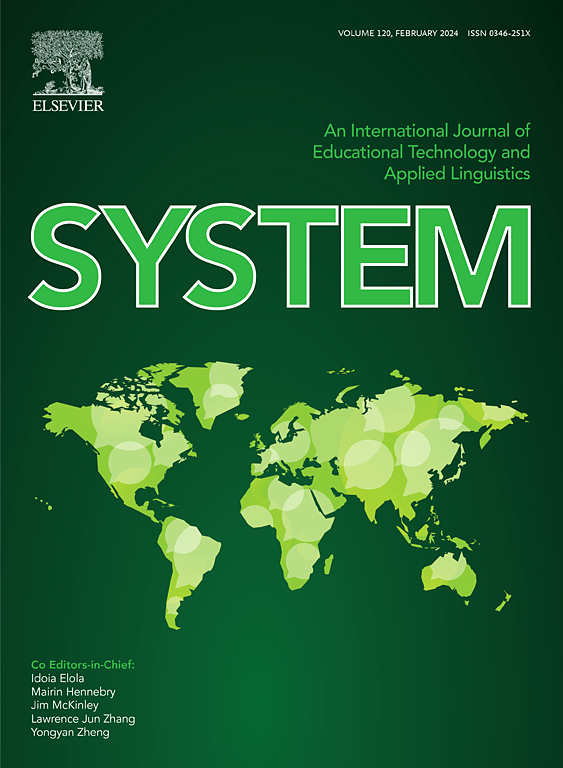An eye-tracking and neuroimaging study of negative wording effects on cognitive load in a metacognitive awareness tool
IF 4.9
1区 文学
Q1 EDUCATION & EDUCATIONAL RESEARCH
引用次数: 0
Abstract
We compared the extraneous cognitive load imposed by two wording conditions: negatively worded and non-negated items in an L2 questionnaire. The questionnaire is the metacognitive awareness listening questionnaire (MALQ), a widely used instrument for assessing metacognitive awareness strategies. Respondents' (N = 109) eye movements measured by an eye-tracker and brain activation levels measured by functional near-infrared spectroscopy (fNIRS) were obtained to examine their extraneous cognitive load in responding to MALQ. Using MANOVA, we identified distinct gaze behavior associated with negatively worded items, indicating that the presence of such items may increase extraneous cognitive load. In addition, English-as-a-second-language participants generally exhibited higher extraneous cognitive load than their L1 counterparts. The results of the neuroimaging investigation further indicated that negatively worded items require more visual attention and cognitive effort, while positively worded items may engage higher-order reflective processing in the brain, highlighting a complex interaction between attention and extraneous cognitive load. Additionally, linear mixed effects models showed that although the models under the two-wording conditions explained a significant amount of variation in respondents’ MALQ scores, they had relatively lower explanatory power (R2) though better global fit compared to the models based on the five constructs that MALQ measures (planning-evaluation, directed attention, person knowledge, mental translation, and problem-solving). We suggest that a balanced approach that considers both the target constructs and the negeative wording effect might be the most effective strategy in questionnaire design and validation. Further implications of these findings are discussed.
元认知意识工具中消极措辞对认知负荷影响的眼动追踪和神经影像学研究
在二语问卷中,我们比较了两种措辞条件:消极措辞和非否定措辞所带来的外在认知负荷。该问卷是元认知意识听力问卷(MALQ),是一种广泛使用的元认知意识策略评估工具。研究人员利用眼动仪测量了109名被调查者的眼动,并利用功能性近红外光谱(fNIRS)测量了他们的脑激活水平,以检验他们对MALQ反应的外来认知负荷。通过方差分析,我们发现了与负面词汇相关的凝视行为,表明这些词汇的存在可能会增加外部认知负荷。此外,以英语为第二语言的参与者普遍表现出比母语参与者更高的外部认知负荷。神经影像学研究结果进一步表明,消极词汇需要更多的视觉注意力和认知努力,而积极词汇可能会在大脑中进行高阶反射处理,突出了注意力和外部认知负荷之间的复杂相互作用。此外,线性混合效应模型显示,尽管双词条件下的模型解释了被调查者MALQ得分的大量变化,但与基于MALQ测量的五个结构(计划评估、定向注意、人物知识、心理翻译和问题解决)的模型相比,它们的解释能力(R2)相对较低。我们认为,在问卷设计和验证中,考虑目标构念和负面措辞效应的平衡方法可能是最有效的策略。讨论了这些发现的进一步含义。
本文章由计算机程序翻译,如有差异,请以英文原文为准。
求助全文
约1分钟内获得全文
求助全文
来源期刊

System
Multiple-
CiteScore
8.80
自引率
8.30%
发文量
202
审稿时长
64 days
期刊介绍:
This international journal is devoted to the applications of educational technology and applied linguistics to problems of foreign language teaching and learning. Attention is paid to all languages and to problems associated with the study and teaching of English as a second or foreign language. The journal serves as a vehicle of expression for colleagues in developing countries. System prefers its contributors to provide articles which have a sound theoretical base with a visible practical application which can be generalized. The review section may take up works of a more theoretical nature to broaden the background.
 求助内容:
求助内容: 应助结果提醒方式:
应助结果提醒方式:


